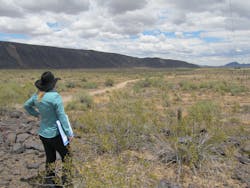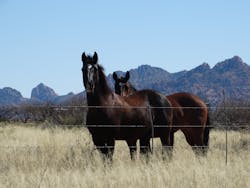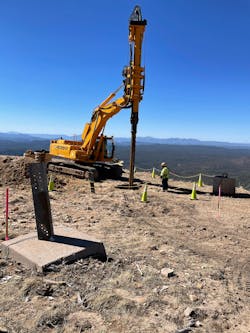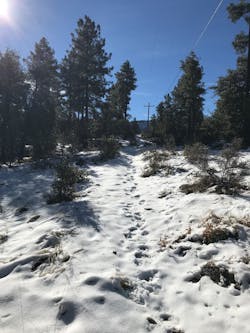Sometime around midnight, transmission foundation engineer Ashley Shirer awoke in her tent. Alone save for her dog, Shirer had heard a low, threatening growl that suddenly made her aware of how thin the walls of her tent were.
She quickly took stock of her situation. Her dog was shaking in her lap, terrified. She had a survival knife with her and a small caliber side arm, neither of which she thought would do much against what might be skulking around outside.
“I had to be brave enough to look out as I could not shoot what I could not see. There was also the possibility of hitting something I did not want to strike, let alone the possibility of lying there waiting for something to crash through the tent,” Shirer said.
With her tent pitched in the steep, narrow canyon and the moon low, the only available light came from Shirer’s headlamp as she slowly climbed out of the tent and onto the campsite picnic table – the idea being to make herself look large and threatening to any wild animals.
“My head was on a swivel, when my eyes caught a glint of gold reflected from the dark in my direction,” Shirer said. “I aimed a shot up in the air, but the eyes that glowed back did not move. The sound and my stance on a table were clearly not threating enough.”
The second time she fired, Shirer aimed for the eyes themselves, not expecting to hit it or, if she could, to do much damage. But the eyes disappeared into the night.
After running back to her tent for her keys, Shirer hit the panic button in hopes the noise would keep the animal frightened away long enough to cover her escape in her vehicle.
“I realized even though I had read about the possible dangers where I was camping – tying food up, using ammonia to mask the sent, having water to put out a fire, even arming myself – I was not truly prepared,” Shirer said.
Even though she was in an official campsite, there was a game trail nearby, trees with low-hanging branches and a source of water, each of which are useful to mountain lions on the prowl for prey or mates.
This close call did not happen while Shirer was on the job, but it did shape how she now conducts her field work. As a geotechnical engineer responsible for designing transmission line foundations, her job requires her to walk alignments to identify geologic and other design factors.
“I am often the first in the field on these projects as my work identifies risks that effect foundations but also structure location and design. Before I go into the field, I do detailed analysis of the possible risks filling out a risk mitigation form, knowing that even the best form will not account for all possible scenarios,” Shirer said.
For Shirer’s work, this means calling the local forest service and fish and game departments as they know the terrain better and know the potential risks.
“Prior that the run-in with the mountain lion, I felt comfortable in the woods. Now I am humbled by knowing there are so many factors to consider to keep myself and my staff safe,” she said.
Transmission lines are often located in far-flung areas, far from city amenities and many other people. Field workers like Shirer often have to venture onto land managed by the USDA Forest Service, the Bureau of Land Management, private property or tribal lands.
Arizona alone is home to more than a dozen species of venomous snakes, scorpions, bears, wolves, coyotes, foxes, lynx, javelina and other species that may defend themselves against perceived threats. Even the plant life can be dangerous, like the cholla, whose every surface is lined with barbed spines that seem to jump onto passing animals. This is to say nothing of the inherent danger of working where the elements are a factor. Flash floods, storms, hail, lightning, extreme heat and cold and other severed weather can pose dangers to workers in remote areas.
Joe Weathersby, Supervisor of Construction Maintenance at Arizona Public Service, has worked in remote areas for most of his career. He pointed out that animals, plants and the elements are not the only potential threats to remote workers.
Weathersby said he was conducting routine substation checks near the US-Mexico border when he noticed the service road had become washed out.
“I exited my vehicle and began to walk the rest of the way to the substation, trying to beat the sun as it was already late afternoon. As I proceeded down the two track now on foot with the essentials; water, paperwork and phone (which did not have any reception),” Weathersby said.
The sun was setting faster than Weathersby anticipated, so he performed his inspection safely yet quickly and started back for his truck.
“I was caught off guard when I heard voices, which is odd in such a remote area this late at night in the middle of the week. I quickly walked off the two-track trail and found some dense brush to hide under while I waited for the approaching voices to pass me,” he said. “As the voices became clearer and the group of people came closer to my position, I sat as quietly as I could for about 30 minutes and watched as more than 10 men walked by in a line with back packs covered in burlap.”
The group passed without noticing him and Weathersby made it back to his truck safely without any further encounters.
Weathersby said he made several mistakes that led up to a potentially dangerous situation. For example, pushing to perform an inspection so late in the day in a remote area. Also, he said he was wrong to rely on his cell phone rather than one capable of making calls in a far-flung spot. Working alone in such a situation was also not the best idea.
Too much time pressure on utility workers, he said, can lead workers to take risks. People need to be able to stop and think before acting and reflecting on how they could have done it better.
“In my case, I later realized that no one knew where I was at that exact moment and if things went badly, I would have been on my own without anyone knowing where to find me,” he said.
Eric Eriksen is currently Vice President of Engineering Operations for the Northwest Lineman College, but before that he was Vice President of Transmission and Distribution for Alaska Electric Light & Power, an Avista Utilities company. In Alaska, he and his colleagues frequently had to prepare for and deal with potential on-the-job hazards.
“What most places would refer to as ‘extreme’ was known as a typical day in Alaska,” Eriksen said.
Almost all infrastructure are located in remote areas, power lines are installed in difficult conditions, avalanches are a threat to people as well as equipment, and travel to many areas was not possible without specialized vehicles like float planes, helicopters, watercraft, off-road vehicles or snow vehicles.
“Bears were frequent events. Eagle-related outages were frequent. One time an eagle picked up a deer carcass from a hunter and flew it into the air and dropped it on top of a 69 kilovolt switch,” Eriksen said. “Due to bears, we would issue firearms, bear spray and training to personnel. We also had strict check-in/check-out procedures for personnel transport, and communications.”
Working on remote power lines usually required carrying a satellite phone and performing regular check-ins while on the job.
“Any hazard while working remote is life-threatening. For example, I recall a lineman who dropped a wrench from a 150-foot lattice tower. He climbed down to the ground to retrieve it but was stung by a bee. He climbed to the top of the tower. In that time, he learned he was allergic to bees and his face and airway was swelling shut,” Eriksen said.
Even with a helicopter dispatched to the scene of the accident, getting the line worker to a hospital was going to take an hour. Luckily, a first responder had an epinephrine injector and the worker made it to the hospital and recovered.
“Bears are daily visitors when working on remote lines. They like lunches and any fuel or petroleum product, which can be a constant challenge for crews to avoid direct interaction,” Eriksen said.
In one incident, Eriksen responded to a residential outage and was inspecting a meter base when he was cornered by a black bear.
“I didn’t have any escape route, and fortunately my training allowed me to successful deter the bear, who ran away,” he said.
In Alaska, as in other areas, it is common for remote crews to maintain survival packs in case they need to spend extra time away from civilization. These can include shelter gear, food, water and the training to use it.
Line workers for Alaska Electric Light & Power can be so well trained for these kinds of hazards that they are often requested to support search and rescue operations, he said.
Keith Pancake, who has worked as a safety manager for ACRT and Bermex, said he had many encounters with black bears and mountain lions. In the Idaho panhandle, colleagues joked you could tell the difference between a black bear and a grizzly is that a black bear will chase you up the tree and eat you while the grizzly will tear the tree down and eat you.
“As entertaining as that sounds, it is far from the truth. Every grizzly bear I encountered either on foot or horseback was more interested in whatever it was eating – grubs, berries, carrion – than me. I was definitely aware of the potential and typically noticed them from a great distance, allowing me to back away with no incident.
While camping in the Boundary Waters Canoe Area Wilderness at the Minnesota-Canada border, Pancake said a sow bear kept returning to their campsite persistently.
“Oddly, she kept returning and for hours we continued to scare her off. At daylight, we ventured further away to investigate, and two cubs were afraid and hungry on the other side of our camp. The sow was simply trying to get to them,” Pancake said. “Fortunately, we weren’t harmed which says a lot about the temperament of black bears and how humans can deter them by relatively simple techniques.”
Even though bears will sometimes give people the benefit of the doubt, they must always be treated as potential threats.
Daren Boyd, an Operations and Maintenance Specialist for Western Area Power Administration took a break from conducting line worker training in the small town of Kremmling in north-central Colorado to share his experiences with working in rugged, mountainous and snowy areas.
Boyd said staying dry in low temperatures is crucial, as one communications worker learned while trying to dig a snow vehicle out of a drift.
“One crew member had on your typical Carhartt insulated coveralls. These are quite warm, but made of cotton exterior that, when working in the snow, become very wet,” Boyd said. “We did get the Snowcat free, and all were returned safely before nightfall came. However, if someone was to get that wet and have to stay outside, even inside the snowcat, in sub-zero temperatures, the health risk is very high.”
In severe weather, conditions can change in an instant and elevate risks to workers.
“This is why we make efforts to provide winter survival to our crews that are at risk of being in remote locations far from the safety of a highway or civilization. This training is very important and is taken very seriously, as if a life is dependent on it because it very well may be just that,” Boyd said.
An unexpected threat is the dangers posed moving from jobsite to jobsite. Oncoming traffic, wildlife and inclement weather on roads are all hazards that need to be considered.
“It sounds simple I know but our crews put on several thousands of miles each month usually driving out each week and then safely home each weekend. Complacency is taken seriously because that is what usually catches all of us off guard really. Just doing what you do every day, you risk being complacent and not keeping your mind on task,” Boyd said.
Staying prepared for the elements and anything they may throw at you is the best way to make sure workers stay on the job, healthy and safe, year after year.
“I suppose if I were to give a tip to anyone simply living day to day trying to get from one place to another and back safely is: Be where you are,” Boyd said. “Keep your mind on task because most of what can injure you is right there next to you where you are at any given time.”
Tips for Remote Work
Ashley Shirer, PhD PE RPA for Holocene Engineering:
- Learn about the environment you are working in, including animals, plants and climate.
- Talk to locals, including government agencies and other authorities who can warn you of potential risks.
- Be able to identify snakes, as not all hospitals have the right type of antivenom.
- Know the hunting season and what lots you may be crossing.
- Have regular planed check in times and locations with the office.
- Make sure all staff have each other’s contact information.
Daren Boyd, an Operations and Maintenance Specialist for Western Area Power Administration:
- Keep dry in cold conditions.
- Use appropriate personal protective equipment (PPE) for the job.
- Remember safety training and take it seriously. This provides a safe workplace for you and your co-workers.
- Stay alert and well-rested when driving long distances.
- When outdoors, be aware of any changes the weather is likely to take during your workday.
Joe Weathersby, Supervisor of Construction Maintenance at APS:
- Keep in good communication when working remotely and do not rely only on a cell phone.
- Do not rush to complete one last job before dark. It may take longer than you expect.
- With people, most situations can be de-escalated by using a calm voice and a reassuring approach that you are willing to work with them on their concern.
- Have an exit plan for if a situation becomes dangerous.
Keith Pancake, Safety Manager, ACRT and Bermex:
- If a bear is visible, but not close, alter your route so that you move away from its area.
- Do not run from predator animals. They have a natural response of chasing you.
- Never corner a wild animal.
- If a bear attacks, it is suggested to fight back using everything in your power: fists, sticks, and rocks.
- If confronted by a mountain lion, make eye contact and do not turn your back, bend or crouch.
- People have used rocks, jackets, garden tools, tree branches, and even bare hands to turn away cougars.
- For hostile animals, EPA registered bear pepper sprays are available, but they require a certain level of training which is offered by many outfitters. Safe storage and carrying are also crucial.
Eric Eriksen, Vice President – Engineering Operations at Northwest Lineman College:
- Have the right training and equipment for the job.
- Have an emergency response plan.
- Reflect after an incident to go over what can be learned.
- Have and maintain survival gear when in a situation where you might need to stay in the field longer than expected.
About the Author
Jeff Postelwait
Managing Editor
Jeff Postelwait is a writer and editor with a background in newspapers and online editing who has been writing about the electric utility industry since 2008. Jeff is senior editor for T&D World magazine and sits on the advisory board of the T&D World Conference and Exhibition. Utility Products, Power Engineering, Powergrid International and Electric Light & Power are some of the other publications in which Jeff's work has been featured. Jeff received his degree in journalism news editing from Oklahoma State University and currently operates out of Oregon.








